Sliding doors are now something of a must-have for many homeowners – and it isn’t hard to see why. Thanks to new manufacturing techniques, not only are they the perfect way to incorporate larger than ever expanses of glass into your house design, but they’re also available with incredibly slim frames, making them the ideal way to frame views and allow natural light to pour in.
Our complete guide to sliding doors will equip you with all the information you need to choose the right products for your home, whatever its style.
Why choose sliding doors?
For anyone wondering why they should choose sliding doors, we have all the answers. The benefits of sliding doors are numerous, no matter whether you are building from scratch, renovating an older property or adding an extension, perhaps as part of a remodelling project.
Here are some of the key reasons why so many people opt to install sliding doors:
- Huge expanses of glazing: Sliding doors are available in many different sizes, offering the possibility to create a truly breathtaking feature in your home and flooding the interiors with light. In the case of aluminium sliding doors, and depending on the model you choose, door sets from Origin are available in sizes up to 13.2m wide and up to 3m tall.
- Slim sightlines: One of the most attractive features of sliding doors is the slim sightlines they offer – meaning less frame and more glass. In the case of Origin’s Slider OS-29+, sightlines of just 29mm are possible so that nothing will get in the way of your views of the great outdoors.
- Connection with the outdoors: By including sliding doors in your home design, you will be creating the perfect way to blur the boundaries between the inside and out. They can be completely opened up, effectively creating a disappearing wall, so that in the summer months, your garden becomes an extension of your home.
- Energy efficiency: Sliding doors, and in particular those made from aluminium, are more energy efficient than ever these days. For example, Origin’s OS-44 and OS-77 models reach an impressively low U-Value of 1.3 when fitted with triple glazing.
- Space saving: Sliding doors require no outswing space (unlike French doors) and no stacking space (as with bi-fold doors), so they are the ideal solution for those with limited space.
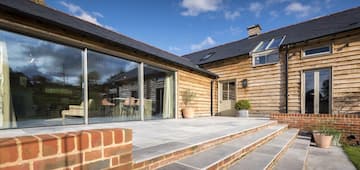
Sliding door types
There are many sliding door types out there, which can make choosing the right style for your home confusing. We’re here to explain the various sliding door types out there in order to make your decision as stress free as possible, focussing on the different materials you can select from.
The sliding door material you opt for will play a large role in how well the doors perform, how much they cost, the maintenance they require and the overall look of your home. You should pick the material that most closely meets all of your requirements, and be sure to think long term, considering durability and upkeep, rather than thinking about your immediate needs alone.
The most popular materials available are:
Timber: Timber is a classic choice for sliding doors and is often selected by those looking for a traditional look for their home.
Pros:
- Can add character to period properties
- Ideal for those who want a natural material
- Thermally efficient
Cons:
- Expensive
- Can be prone to twisting, warping or rotting
- Needs maintenance in terms of sanding, priming and regularly staining or painting
- Can be damaged more easily than some other materials
Composite: Composite sliding doors have aluminium outer frames, with a timber finish internally.
Pros:
- Offer the warmth of timber internally
- Feature durable, maintenance-free aluminium exteriors
- Good thermal efficiency
Cons:
- More expensive than some other materials
- Can ‘creak’ during warmer weather
uPVC: uPVC sliding doors are often chosen by those on a tight budget, although their price varies considerably.
Pros:
- Widely available
- Good product choice
- Affordable
Cons:
- Chunky frames and thick sightlines
- Less glazing
- Higher thresholds
- Can discolour over time
- Hard to achieve an authentic look
- Thermal expansion is a common issue
- Small choice of hardware
Aluminium: Aluminium sliding doors are one of the most popular choice these days, thanks to a long list of advantages that easily outweigh their cost.
Pros:
- Very slim sightlines possible
- Can be manufactured in sizes taller, wider and overall larger than other materials –particularly uPVC
- Extensive colour choice
- Superior thermal efficiency
- Eco-friendly
- Can be constructed to avoid overheating or ‘the greenhouse effect’
- Recessed track possible
- Great for both contemporary and traditional properties
- Many configurations available
- Brilliant security
- Virtually maintenance free
- Durable
Cons:
- More expensive than uPVC
Aluminium sliding doors
Aluminium sliding doors make a fantastic choice for owners of all styles of home and are the perfect way to finish off extensions and remodelling projects, as well as self-builds and renovations.
Aluminium sliding doors lend a fresh, modern look, instantly updating the kerb appeal of a house and are a feature that, should you decide to move on, will attract potential buyers thanks to their many benefits.
The other great thing about the sleek appearance of aluminium sliding doors is that they not only suit contemporary properties brilliantly, but will also fit in with more traditional style homes, where they can either blend in or create a nice contrast between the newer and older sections of a house in the case of extensions – something often encouraged by local planning departments keen for a definition between old and new.
From an energy efficiency perspective, aluminium sliding doors are also a smart choice. They have the ability to keep the warmth in during colder months and the heat out during the summer. Remember though, not all aluminium sliding doors are created equal, so make sure you are buying from a reliable supplier – all Origin Sliding Doors meet and exceed the British Regulation standard for thermal efficiency and the OS-44 and OS-77 models can reach U-Values of just 1.3 when fitted with triple glazing.
Aluminium is a strong, durable and lightweight material, meaning even very slim frames can support enormous glass panels with no detrimental effect on the security of the doors and no risk of movement. It is also an eco-friendly choice thanks to the fact that it is 100% recyclable.
Other features that draw people to aluminium sliding doors include the fact that they can be powder coated in a huge range of RAL colours, require little maintenance when it comes to upkeep and offer unrivalled security options.
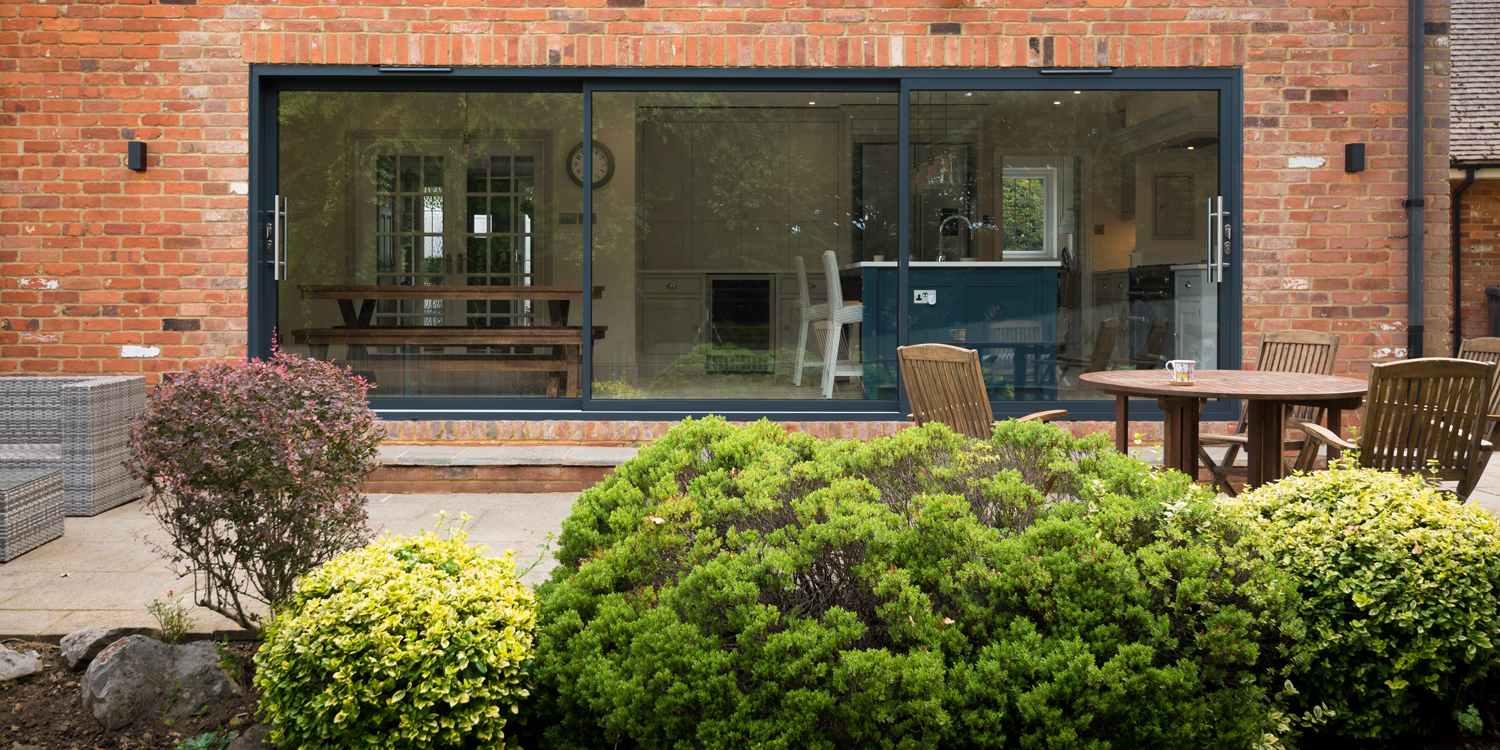
Sliding doors cost
The cost of sliding doors varies depending on a number of factors, including the glazing you opt for, installation fees, materials, style, configuration, size, and even the hardware you decide upon.
While a material such as uPVC tends to appeal to those on a tight budget, it pays to consider how they will weather over the years. Aluminium sliding doors are undoubtedly more expensive, but they add value, require no maintenance costs and will outlive many other styles of sliding doors, making them a sensible and worthwhile investment.
Fitting sliding doors
When it comes to fitting sliding doors there are several factors to be taken into account. Fitting sliding doors is quite different from installing bi-fold doors, French doors or even a new front door.
The complexity of the fitting process depends largely on the size and configuration you choose. Very simple twin panel sliding doors will be less time consuming to install than a six-panel configuration. You will also need to discuss your threshold (more commonly referred to as a track in the case of sliding doors) requirements with your chosen installer – a track set into the ground, for example, will have a different set of requirements to a raised one.
Fitting sliding doors is definitely a job left to the professionals, who will be able to advise you on the best route depending on your build schedule and any site conditions that could affect installation. To remove the risk from finding a reliable installer, here at Origin, we offer our installers training in installation, product knowledge and customer service.
Sliding door sizes
There is a huge range of sliding door sizes and many companies, including Origin, offer a bespoke product to ensure that there are sliding door sizes to suit all projects. Although it is common these days to see great swathes of full-height glazing running the full width of houses, it is just as possible to specify more compact sliding door sizes for smaller properties or extensions.
Opting for aluminium doors made from a high-grade material will ensure you have the biggest choice when it comes to sizes. As an example, Origin’s Slider OS-29+ is able to accommodate panel sizes of up 2.2m wide and 3m tall, in a configuration of up to six panels in an opening up to 13.2m. The OS-29, OS-44 and OS-77 models can be configured to take up to six panels in an aperture of up to 11.8m.
Sliding door configuration
When selecting your doors, you will need to decide on the sliding door configuration that will most suit your needs and your home.
The great thing about sliding doors is that they can be custom made in a wide range of configurations, usually from two panels right up to six. These panels can be configured to slide either left or right, while some come as double doors that slide away from one another. Within the configuration, it is usual for some of the panels to be fixed.
Your chosen sliding door configuration will dictate the track type required – so two panes on a double track enables panels to open at either end and those on triple track systems allow many sliding panes to stack on top of one another. Speak to your local installer if you’re unsure what your best option is.
Sliding Door Sightlines
Two of the main attractions of aluminium sliding doors are that they are available in impressively large panel sizes and, thanks to advances in technology, can have slimmer sightlines than ever before.
The term ‘sightlines’ refers to the width of the frame or profile between each pane of glass –the slimmer the sightline, the better the view as there is more glass and less frame.
Origin Doors have the benefit of offering incredibly slim sightlines – the OS-29+ Slider model boasts sightlines of just 29mm, and the OS-44 and OS-77 Patio Sliders offer sightlines of just 29mm, 44mm or 77mm.
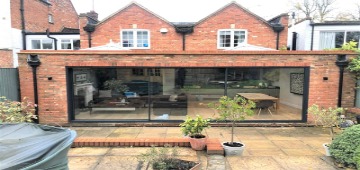
Sliding door tracks
Unlike bi-fold doors, where there are several types of threshold options to choose from, when it comes to sliding doors, there is one type of track but it’s available in a double or triple formation.
Sliding doors work by sliding open and closed horizontally along a mechanism called a ‘running gear.’ This sits at the bottom of each door and moves along inside the door track.
The doors you choose and the configuration you opt for will affect which type of sliding door tracks you can have. For example, two track options are available for both the Origin Artisan Slider and Origin Patio Sliders – a double or triple track. The configuration you choose will determine which you should go for, with the double track being suitable for two door sets, and the triple track option being suitable for configurations of three or more doors, either all sliding or with one fixed and two sliding.
If you are keen on creating a seamless, level threshold between inside and out, opt for tracks that can be recessed into the floor, such as those by Origin. Not only will they look great, but they also make it less likely that fingers or toes will get trapped in them. If you do want it recessed, your installer will need to make allowances for drainage.
Are sliding doors energy efficient?
Given that installing sliding doors means you are effectively creating one large glass wall in your home, you would be forgiven for asking, ‘are sliding doors energy efficient?’ Not only is this an important consideration for homeowners keen to up the eco credentials of their property, but it is also worth thinking about from the perspective of your heating bills – energy efficient sliding doors can help lower the running costs of your home.
Origin’s aluminium sliding doors are all thermally broken, meaning any transfer of heat between inside and out is minimal. The Slider OS-29+ comes as a bonded system with the glass and uses low-emissivity glass that reflects heat back into the room in which it is fitted. This exceeds British Building Regulations thanks to it being able to achieve U-Values of just 1.4.
Aluminium sliding doors are available with either double glazed panels or triple glazing. The choice between double or triple glazing comes down to your own individual requirements, but there are a few factors that you should bear in mind when it comes to choosing the right option for you. It is worth noting that that Origin Patio Sliding Door system can deliver a U-value of 1.3 for triple glazing and 1.6 for double glazing. And the Slider OS-29+ is a ‘bonded system’, meaning the glass and frame come as one unit.
Double glazed sliding doors
Double glazed sliding doors consist of two panes of glass with an air gap between, usually containing an inert gas, such as argon. Being heavier than air, the inert gas acts as a great insulator of both heat and noise. You can further enhance the energy efficiency of double glazed sliding doors by ensuring you choose a product with thermal bridging and airtight frames – aluminium sliding doors are ideal for this.
Triple glazed sliding doors
Although triple glazed sliding doors cost more than double glazed versions, there are many benefits that offset the extra costs. It may be worth considering triple glazed sliding doors if you are building or renovating and are aiming to achieve Passivhaus standards, for example. Likewise, if noise is an issue, triple glazing will offer more in the way of sound insulation than double. Triple glazed sliding doors feature three panes of glass, meaning there are two air locks rather than just one – increasing the energy efficiency of the doors by up to 50%.
Are sliding doors secure?
When considering sliding doors for their home, it is only natural that many homeowners are left wondering, ‘are sliding doors secure?’ Happily, the answer is yes, providing you choose a reliable manufacturer, installer and specify a high quality locking option.
Sliding glass door locks differ from the lock systems for other entrance doors, such as standard hinged front doors or French doors. A common locking system for sliding doors uses clasp locks that combine a clasp mechanism with a lever on the sliding door. It is also usual to fit foot bolts in the top and bottom corners of the doors, along with an additional spring bolt. Another option are cylinder locks. These are operated with a key and can be fitted to the end or centre of the door.
Ideally, you want to choose a multi-point locking system. Origin’s OS-29+ Slider has a multi-point lock that features six points of locking with a cylinder and interior lever locks –there is no handle or door lock on the exterior of the door, meaning no lock for intruders to pick. Opting for the low e-toughened premium glass will make your sliding doors even more secure.
If you were to opt for Origin’s OS-44 or OS-77 Patio Slider, you would also have a multi-point locking system – this will come with with either an all-in-one handle and or an offset handle with a separate locking escutcheon.
Finally, if you are still wondering whether sliding doors are secure, you should ensure your doors meet the stringent PAS 24:2016 security standards.
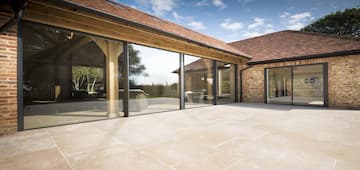
Do you need planning permission for sliding doors?
Although you won’t usually require planning permission for sliding doors, there are always exceptions to the rule. If you live in a designated area, such as a Conservation Area or Area of Outstanding Natural Beauty, you may well need to consult with your local planning authority as to what will be deemed acceptable. If you live in a listed building, you will almost certainly need listed building consent. In all cases, it is always worth checking before you go ahead with installation in order to avoid any problems further down the line.
Regardless of whether or not you require planning permission for sliding doors, the Building Regulations are definitely something you need to adhere to as since 1st April 2002, Building Regulations have applied to all replacement glazing and include requirements surrounding thermal performance, safety, air supply and means of escape.
You can find the Approved Documents relating to new sliding doors by visiting the Planning Portal website.
Sliding door maintenance
The amount of maintenance required for sliding doors depends on the material you choose.
While timber sliding doors will require painting, staining or sealing on a fairly regular basis to ensure they remain in good working order and looking their best, there is very little maintenance required when it comes to aluminium sliding doors. A simple wipe down with a mild soapy solution is usually enough to keep doors looking good — and don’t forget to check tracks for dirt and debris periodically, as well as ensuring seals are kept clean. More maintenance will be required in certain areas. See our terms and conditions for details.
Sliding doors vs bi-fold doors
Bi-fold doors differ from sliding doors in that the panels open by sliding and folding along a top and bottom track, concertina style, up against each other. They can include an access door and can open up spaces completely. On the downside, they tend to have thicker sightlines and more frame than sliding doors and need space to stack up.
In comparison, sliding doors have slimmer sightlines, take up less space when opened up and provide unobstructed views thanks to large pane sizes. However, it is worth bearing in mind that sliding doors will never be fully able to be open as one pane of glass will always be visible.
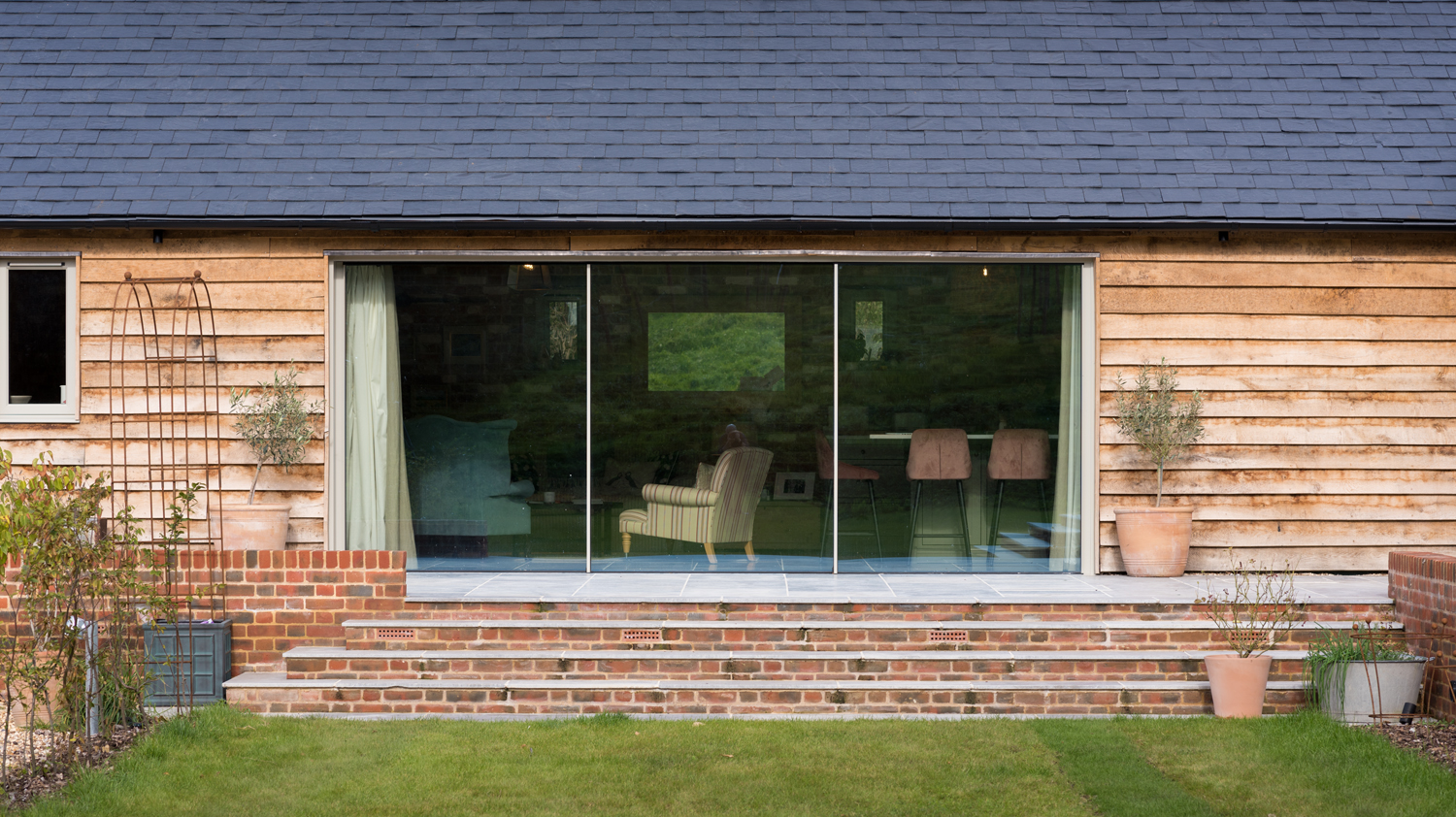
Sliding doors vs French doors
French doors are a classic choice when it comes to specifying patio doors, yet there are now many other alternative options. French doors are affordable, perfectly suited to traditional style and period homes, and can provide the ideal way to create a connection to the outdoors in smaller spaces. That said, Origin is able to fit them into openings of up to 2.4m — and if you opt for fixed panes on either side you can go even bigger, as each fixed frame can be made up to 7m2.
Compared to sliding doors, they do not offer the same potential for unbroken views as the sighlines are not as slim. They also require space in order to be opened up. Sliding doors tend to be a better option for those after a sleeker, more contemporary aesthetic for their home.
Sliding doors ideas
After some inspirational sliding doors ideas? Here, we round up some of the most stylish ways to use them.
Sliding doors for patio
Make the most of your outdoor spaces by fitting sliding doors for patio areas – not only will an expanse of glass give fantastic views of your patio from within, but they can almost turn it into an extension of your home in the summer months.
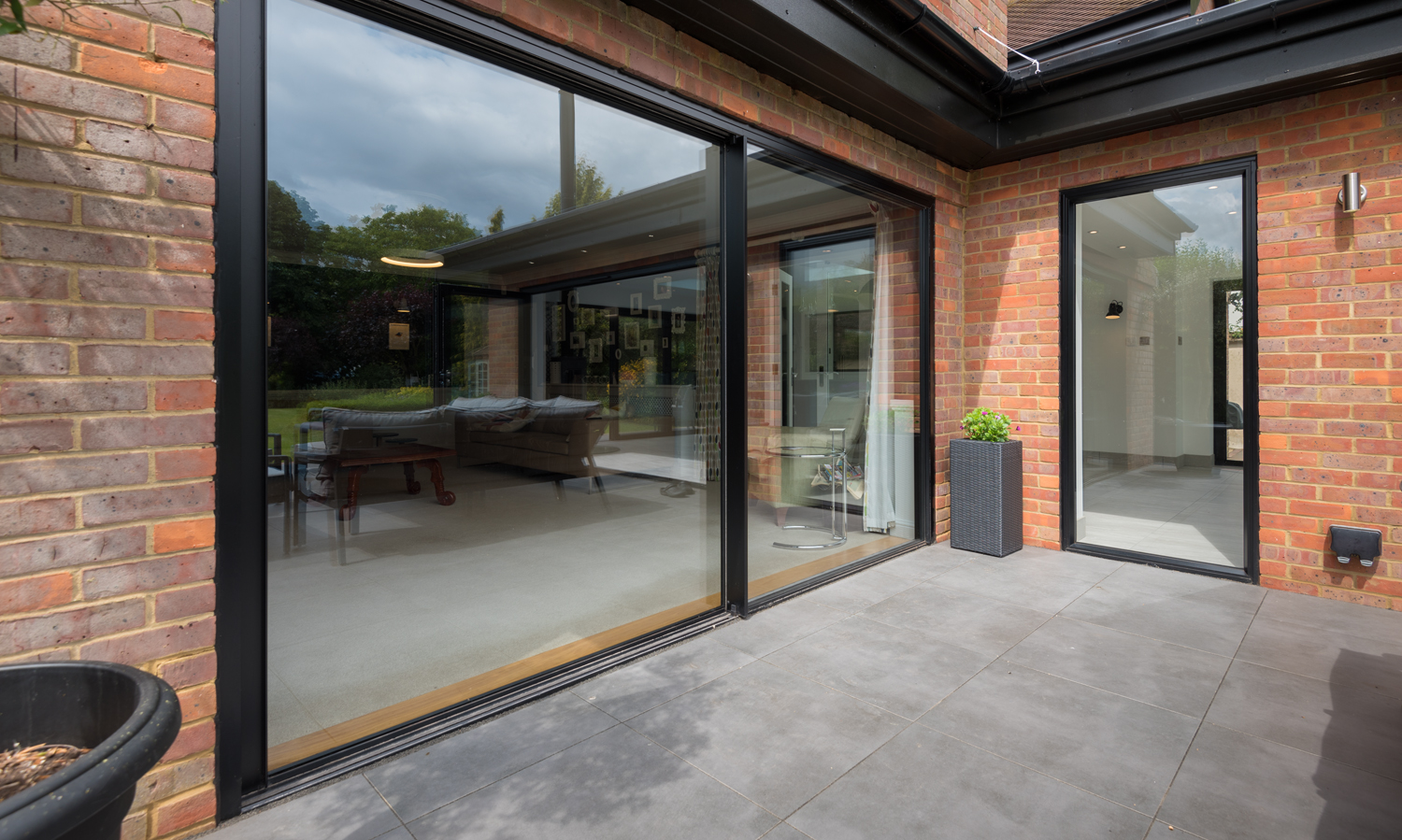
Sliding doors for extensions
It makes perfect sense to consider sliding doors for extension projects. They are a particularly great idea for rear extensions, allowing the entire back of your home to be opened up to the garden and really increasing the sense of space inside.
Sliding doors for kitchen
A hugely popular choice at present are sliding doors for kitchen diners. Having sliding doors in a kitchen works particularly well where they lead out to an external paved area, turning it into an easy-to-access outdoor dining room.
You could also use your doors to highlight the colour scheme in your kitchen – powder coated sliding doors are available in a huge range of RAL colours.

Sliding doors for conservatories
One of the main reasons people choose to have a conservatory is to be able to enjoy their gardens and outdoor spaces all year round – so choosing sliding doors for conservatory set ups is a fantastic idea, increasing the views available and merging the entire space with the outdoors.
Double sliding doors
Have you considered double sliding doors? This style of door features panels that slide in opposite directions away from one another and are particularly popular for smaller projects.
Industrial-style sliding doors
Also called steel-style doors, these are a great option for those keen to inject some character and individuality into their home. Aluminium steel-style sliding doors combine industrial chic with the thermal and lightweight benefits of aluminium frames.
Keen to get started on your project? Take a look at our Sliding Door Brochure
